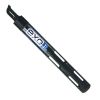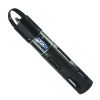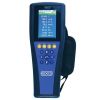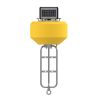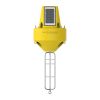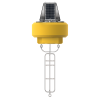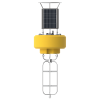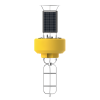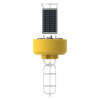YSI EXO2s Multi-Parameter Water Quality Sonde
Features
- Ideal for spot sampling or attachment to data buoys, AUV's, drones, etc.
- Smaller, lighter sondes can be deployed in tight spaces
- A more budget-friendly EXO without alkaline batteries
- Expedited repair and warranty service
- Lifetime technical support
- More
Overview
The YSI EXO2s represents an advanced sonde platform that offers a wide range of capabilities to those dedicated to monitoring natural aquatic environments such as oceans, estuaries, rivers, lakes, and groundwater. The YSI EXO2s is a compact, batteryless sonde that comes with the same capabilities as the EXO2, and is ideal for specialized applications where external power is supplied. With a highly efficient power management platform, robust construction, and a chemistry-free anti-fouling system, the YSI EXO2s allows accurate data collection for up to 90 days between service intervals.
Multi-Port Water Quality Sonde
The EXO2s sonde includes six sensor ports and a central anti-fouling wiper option. Sensor parameters include:
- Temperature
- Conductivity
- Depth
- Dissolved oxygen
- pH
- ORP
- Total algae (phycocyanin or phycoerythrin along with chlorophyll)
- Turbidity
- Fluorescent dissolved organic matter (fDOM)
- Rhodamine WT
- UV nitrate
- ISE ammonium
- ISE nitrate
- ISE chloride
Outputs Four Calculated Parameters.
- Salinity
- Specific conductance
- Total dissolved solids (TDS)
- Total suspended solids (TSS)
Onboard Signal Processing and Memory
All EXO sensors are digital sensors with onboard signal processing and memory. Built-in sensor diagnostic and calibration data allow users to calibrate multiple sensors in one sonde and distribute them to various other sondes in the field. Wet-mateable connectors allow for swaps in wet conditions, while active port monitoring automatically detects each sensor and verifies operation.
EXO2s Specifications
Diameter: 7.62cm (3.00 in)
Length (with guard): 42.87cm (16.88 in)
Peripheral Ports: 1 power communication port; 1 auxiliary port for third-party sensors (future functionality; not active yet)
Sensor Ports: 7 (6 ports available when central wiper used)
3-Year Warranty: Sonde; handheld
2-Year Warranty: Cables; conductivity/temperature and optical sensors; electronics base for pH, pH/ORP, ammonium, chloride, and nitrate sensors
1-Year Warranty: Optical DO cap and replaceable reagent modules for pH and pH/ORP sensors
3-Month Warranty: Replaceable reagent modules for ammonium, chloride, and nitrate sensors
Weight: 1.06kg (2.34 lbs)
General Sonde Specifications
Power Requirement: 9-16 VDC
Computer Interface: YSIP via USB Signal Output Adapter (SOA) and Bluetooth
Output Options: RS-232 & SDI-12 via DCP-SOA; Modbus & RS-485 via Modbus-SOA
Data Memory: 512 MB total memory; >1,000,000 Logged readings
Depth Rating: 0 to 250m (0 to 820 ft)
Sample Rate: Up to 4 Hz
Operating Temperature: -5 to +50°C (23 to 122°F)
Storage Temperature: -20 to +80°C (-4 to 176°F)
- (1) EXO2s sonde
- (1) Probe guard
- (1) Calibration cup
- (1) Tool kit
- (4) Port plugs
- (1) USB drive loaded with manual & Kor Software
In The News
Save our Bogs! Culture, Conservation and Climate Action in Ireland’s Peatlands
Characterized by long-term accumulation under waterlogged conditions, peatlands exist on every continent and account for 3-4% of the global land surface . Small but mighty, these often overlooked wetland environments are estimated to hold as much as one-third of the world's organic carbon in their soil—twice the amount found in the entirety of the Earth's forest biomass. While healthy peatlands can trap and store carbon, regulate water, and provide important habitats for rare species, human alteration has disturbed peatland carbon and nitrogen cycles on a global scale. Approximately 12% of the world’s peatlands have been drained and degraded through conversion for agriculture, forestry, infrastructure development, and other uses.
Read MoreSargassum Surge: How Seaweed is Transforming our Oceans and Coastal Ecosystems
Until recently, Sargassum –a free-floating seaweed–was distributed throughout the Sargasso Sea , the north Caribbean Sea, and the Gulf of Mexico. But in the space of a decade, this seaweed has, as one scientist remarks , “Gone from a nonfactor to the source of a terrible crisis.” Driven by climate change, anomalous North Atlantic Oscillation in 2009-2010 and a glut of anthropogenic pollutants, sargassum has proliferated. Seasonally recurrent mats as deep as 7m now bloom in the “Great Atlantic Sargassum Belt” (GASB), which covers areas of the Atlantic from West Africa to the Caribbean Sea and Gulf of Mexico. Every year, millions of tons wash up along the shores of more than 30 countries . Dr.
Read MoreGreat Lakes Research Center: Designing Targeted Monitoring Solutions
According to the National Oceanic and Atmospheric Administration ( NOAA ), the Great Lakes have more miles of coastline than the contiguous Atlantic and Pacific coasts combined and contain 20 percent of the world's freshwater, making it a critical region to protect and conserve. Continuous monitoring and data-informed resource management are key components of managing waters in the region. Hayden Henderson, a research engineer with the Great Lakes Research Center (GLRC), designs and deploys monitoring platforms throughout the Great Lakes. With a background in environmental engineering, Henderson enjoyed the challenge of creating systems and making them work to obtain difficult, remote measurements.
Read More



















































